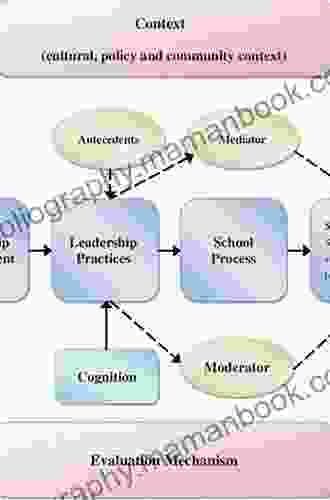Systems Approach to School Leadership: A Comprehensive Guide for Transformational Leadership

In today's ever-changing educational landscape, the role of school leadership has become increasingly complex and multifaceted. To effectively navigate these complexities and drive positive student outcomes, school leaders must adopt a comprehensive approach that encompasses all aspects of the school system. The systems approach to school leadership offers a valuable framework for ng just that. This approach focuses on understanding the interconnectedness of all components within a school system and leveraging these connections to create a cohesive and supportive learning environment.
Key Concepts of the Systems Approach
The systems approach to school leadership is based on the following key concepts:
4.7 out of 5
| Language | : | English |
| File size | : | 2506 KB |
| Text-to-Speech | : | Enabled |
| Screen Reader | : | Supported |
| Enhanced typesetting | : | Enabled |
| Word Wise | : | Enabled |
| Print length | : | 157 pages |
| X-Ray for textbooks | : | Enabled |
1. Systems Thinking:
A systems thinker understands that a school system is not merely a collection of independent parts but rather a complex network of interconnected elements. These elements include students, teachers, administrators, parents, the community, and external factors such as funding and policy. Any change or disruption in one part of the system will have ripple effects throughout the entire system.
2. Interdependence:
All components of a school system are interdependent and rely on each other for success. For example, students' academic performance is influenced by the quality of teaching, the support provided by parents, and the resources available within the school. Similarly, teachers' effectiveness is impacted by the leadership provided by administrators, the professional development opportunities available to them, and the level of parental involvement.
3. Openness:
School systems are not isolated entities but are constantly interacting with their external environment. Factors such as economic conditions, community values, and technological advancements can all influence the functioning of a school system. Leaders must be aware of these external factors and adapt their strategies accordingly.
4. Continuous Improvement:
School systems should be engaged in a continuous process of self-assessment and improvement. Leaders should regularly gather data on student outcomes, teacher effectiveness, and other relevant indicators to identify areas for growth. Based on this data, they can develop and implement strategies to address identified needs.
Benefits of the Systems Approach
Adopting a systems approach to school leadership offers numerous benefits, including:
1. Improved Decision-Making:
By understanding the interconnectedness of all components within a school system, leaders can make more informed and strategic decisions. They can consider the potential impact of their decisions on all stakeholders and take a holistic approach to problem-solving.
2. Enhanced Collaboration:
The systems approach emphasizes the importance of collaboration among all stakeholders. By fostering a collaborative culture, leaders can create a more cohesive and supportive school environment where everyone works towards common goals.
3. Increased Student Outcomes:
When all components of a school system are working together effectively, students benefit the most. They experience a more rigorous and engaging learning environment, which leads to improved academic achievement and social development.
4. Reduced Teacher Turnover:
Teachers are more likely to stay in a school where they feel supported and valued. The systems approach creates a culture of respect and collaboration, which helps reduce teacher turnover and ensures continuity in instruction.
5. Stronger Community Partnerships:
Schools that adopt a systems approach are more likely to engage with the community and build strong partnerships with parents, businesses, and other organizations. These partnerships can provide valuable resources and support for schools and help them become more responsive to the needs of their community.
Implementing the Systems Approach
Implementing a systems approach to school leadership requires a commitment from all stakeholders. Here are several steps that leaders can take to get started:
1. Conduct a System-Wide Assessment:
Start by conducting a thorough assessment of the school system to identify strengths, weaknesses, and areas for improvement. This assessment should include input from all stakeholders, including students, teachers, administrators, parents, and community members.
2. Develop a Shared Vision and Goals:
Once the current state of the system has been assessed, stakeholders should work together to develop a shared vision and set clear goals for the future. These goals should be aligned with the needs of students and the community.
3. Create a Collaborative Culture:
Foster a culture of collaboration and teamwork among all stakeholders. Encourage open communication, shared decision-making, and a willingness to learn from one another.
4. Implement Data-Driven Practices:
Use data to inform decision-making and track progress towards goals. Regularly collect and analyze data on student outcomes, teacher effectiveness, and other relevant indicators to identify areas for improvement.
5. Engage in Continuous Improvement:
Make continuous improvement an ongoing priority. Use data and feedback to adjust strategies and plans as needed. Encourage stakeholders to embrace a learning mindset and seek opportunities for growth.
The systems approach to school leadership provides a comprehensive framework for effective leadership in the 21st century. By understanding the interconnectedness of all components within a school system, leveraging collaboration, and engaging in continuous improvement, school leaders can create a cohesive and supportive learning environment where students thrive. Adopting a systems approach requires a commitment from all stakeholders, but the benefits are undeniable. By embracing this approach, school leaders can foster a culture of excellence and drive transformative change in education.
Additional Resources:
- The Systems Approach to School Leadership: A Framework for Improved Decision-Making and Student Outcomes
- Implementing the Systems Approach in Schools: A Step-by-Step Guide
- The Benefits of Systems Thinking for School Leaders
- Collaborative Leadership in Schools: A Systems Approach
- Data-Driven Decision-Making in Schools: A Systems Approach
4.7 out of 5
| Language | : | English |
| File size | : | 2506 KB |
| Text-to-Speech | : | Enabled |
| Screen Reader | : | Supported |
| Enhanced typesetting | : | Enabled |
| Word Wise | : | Enabled |
| Print length | : | 157 pages |
| X-Ray for textbooks | : | Enabled |
Do you want to contribute by writing guest posts on this blog?
Please contact us and send us a resume of previous articles that you have written.
 Top Book
Top Book Novel
Novel Fiction
Fiction Nonfiction
Nonfiction Literature
Literature Paperback
Paperback Hardcover
Hardcover E-book
E-book Audiobook
Audiobook Bestseller
Bestseller Classic
Classic Mystery
Mystery Thriller
Thriller Romance
Romance Fantasy
Fantasy Science Fiction
Science Fiction Biography
Biography Memoir
Memoir Autobiography
Autobiography Poetry
Poetry Drama
Drama Historical Fiction
Historical Fiction Self-help
Self-help Young Adult
Young Adult Childrens Books
Childrens Books Graphic Novel
Graphic Novel Anthology
Anthology Series
Series Encyclopedia
Encyclopedia Reference
Reference Guidebook
Guidebook Textbook
Textbook Workbook
Workbook Journal
Journal Diary
Diary Manuscript
Manuscript Folio
Folio Pulp Fiction
Pulp Fiction Short Stories
Short Stories Fairy Tales
Fairy Tales Fables
Fables Mythology
Mythology Philosophy
Philosophy Religion
Religion Spirituality
Spirituality Essays
Essays Critique
Critique Commentary
Commentary Glossary
Glossary Bibliography
Bibliography Index
Index Table of Contents
Table of Contents Preface
Preface Introduction
Introduction Foreword
Foreword Afterword
Afterword Appendices
Appendices Annotations
Annotations Footnotes
Footnotes Epilogue
Epilogue Prologue
Prologue Elaine K Mcewan Adkins
Elaine K Mcewan Adkins T Chris Riley Tillman
T Chris Riley Tillman David J Carroll
David J Carroll Roy Thomas
Roy Thomas Lucia St Clair Robson
Lucia St Clair Robson Allene R Lowrey
Allene R Lowrey William Alan Webb
William Alan Webb Susan Aldridge
Susan Aldridge Aaron Watkin
Aaron Watkin Kent Masterson Brown
Kent Masterson Brown Phillip Bryant
Phillip Bryant John G Neihardt
John G Neihardt Tom Medwin Jr
Tom Medwin Jr Blade Pen
Blade Pen Eiichiro Oda
Eiichiro Oda Abbey Cristy
Abbey Cristy Freya Atwood
Freya Atwood Bv Lawson
Bv Lawson Cesar Millan
Cesar Millan Cynthia Eden
Cynthia Eden
Light bulbAdvertise smarter! Our strategic ad space ensures maximum exposure. Reserve your spot today!

 Clark CampbellProcess Innovation in the Global Fashion Industry: A Palgrave Studies in...
Clark CampbellProcess Innovation in the Global Fashion Industry: A Palgrave Studies in... W.B. YeatsFollow ·19.1k
W.B. YeatsFollow ·19.1k Boris PasternakFollow ·2.7k
Boris PasternakFollow ·2.7k Hudson HayesFollow ·17.7k
Hudson HayesFollow ·17.7k Edward BellFollow ·13.2k
Edward BellFollow ·13.2k José MartíFollow ·10.6k
José MartíFollow ·10.6k Preston SimmonsFollow ·16.6k
Preston SimmonsFollow ·16.6k Vince HayesFollow ·9.8k
Vince HayesFollow ·9.8k Cade SimmonsFollow ·8.6k
Cade SimmonsFollow ·8.6k

 Patrick Rothfuss
Patrick RothfussHow to Make a Million Dollars: No Secrets
Making a million dollars...

 Robert Heinlein
Robert HeinleinResponse to Intervention, Second Edition: RTI in Practice
A Comprehensive Resource for Educators and...

 Timothy Ward
Timothy WardUnravel the Gripping Assassination Thriller Bursting with...
Prepare yourself for a...
4.7 out of 5
| Language | : | English |
| File size | : | 2506 KB |
| Text-to-Speech | : | Enabled |
| Screen Reader | : | Supported |
| Enhanced typesetting | : | Enabled |
| Word Wise | : | Enabled |
| Print length | : | 157 pages |
| X-Ray for textbooks | : | Enabled |
















